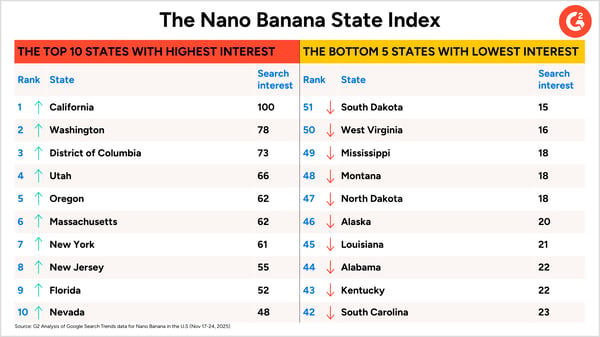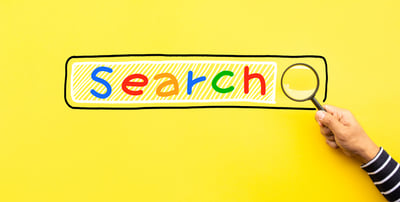November 25, 2025
 by Soundarya Jayaraman / November 25, 2025
by Soundarya Jayaraman / November 25, 2025

Nano Banana, Google's breakout AI image generator, was already having a moment, and now it just got rocket fuel. Last week, Google launched Nano Banana Pro, upgrading the viral image model with sharper outputs and more edit control so it works like a true daily creator tool.
At G2, we analyzed Google search interest from November 17 to 24, 2025, to see where Nano Banana attention is peaking in the United States. The map shows interest clustering in a few clear hotspots rather than rising evenly nationwide.
The Pro version is spiking in the exact same states where Nano Banana interest is hottest, likely indicating that the upgrade is being pulled first by the same early-adopter corridors
Is your state catching Nano Banana fever? Read on to discover which states are driving the surge for the AI image generator and what that early interest might suggest about where the Gemini trend could head next.
Note on methodology: Data comes from Google Trends and reflects relative search interest, not raw volume. Scores are indexed 0–100 for the selected region/time: 100 = peak, 50 = half as popular, 0 = insufficient data.
Based on search interest for the term "Nano Banana" in the past 7 days in Google Search (11/17/25 - 11/24/25)
Search interest in "Nano Banana" by states in the U.S.
Source: Google Trends
As seen in the dark red clusters on the map above, the West is, quite literally, going bananas: California leads U.S. states in searches about Nano Banana, with Washington and the District of Columbia close behind, while a second hotspot stretches across the Northeast through New York, Massachusetts, and New Jersey.
At the other end of the map is South Dakota, showing the lowest curiosity about the trend, followed by West Virginia and Montana, according to G2’s analysis of Google Trends search interest from Nov 17–24.

To make the spread easier to read, we grouped states into tiers based on their seven-day search interest scores.
Taken together, the regional patterns suggest Nano Banana is beginning in tech-forward, creator-heavy hubs and may be expanding into the broader U.S. population, though not evenly.
The highest engagement is clustered in states with dense innovation economies, large creator communities, or strong professional interest in AI. As awareness continues beyond the initial hotspots, the next phase of Nano Banana’s growth may depend on how well it resonates with audiences outside tech and creator ecosystems.
Based on search interest for the term "Nano Banana Pro" in the past 7 days in Google Search (11/17/25 - 11/24/25)
Search interest in "Nano Banana Pro" by states in the U.S.
Source: Google Search Trends
Interestingly, the search trends for "Nano Banana Pro" mirror the Tier 1 footprint almost exactly. California remains the epicenter, with strong momentum across the West Coast and Northeast, plus an outsized spike in D.C. In short, Pro is catching up fastest in the same innovation corridors.
This matters. It suggests that the regions searching for the tool aren't just looking for entertainment; they are investigating the paid, professional upgrade.
Beyond the map, related searches this week show rising Pro intent, with users asking how to try Nano Banana Pro, what it costs, whether it’s free, and how to access the Pro API.
It's worth zooming out to where Nano Banana sits in the broader AI image generator race. On G2, Nano Banana, which falls under Gemini, competes in a top-tier field where several platforms are already vying for creators’ and marketers’ attention.
Gemini on G2: Quick facts
In the current G2 grid, Gemini sits alongside category leaders like Canva, AKOOL, 1min.ai, and Adobe Firefly, which are widely used for fast, workflow-friendly visual creation.
It also competes with tools such as TESS, Microsoft Designer, Freepik, and Midjourney, each bringing different strengths, from design-first polish to high-art image generation.
Why Nano Banana Pro matters here: The "Pro" upgrade strengthens Gemini’s position in this mix by doubling down on what it does differently: a conversational, edit-first experience that lets users iterate quickly without jumping between separate design or generation tools. The tool could influence how market share shifts within the AI image generator category, especially if Pro adoption holds.
Nano Banana’s search footprint looks similar to what we often see with viral AI tools: early adoption clusters first, with interest sometimes spreading outward over time. The West Coast and the Northeast are often the first places where interest in new creator tech peaks, likely driven by dense tech ecosystems, large creator communities, and faster social amplification loops.
In the broader AI race, with heavy competition from OpenAI, Microsoft, Amazon, xAI, Perplexity, and others, this kind of viral, creator-led traction is a small but notable sign that Google may be gaining some ground on the consumer-creator front.
That matters because Nano Banana Pro isn’t being positioned as a one-off meme engine. Google’s upgrade is explicitly aimed at higher-fidelity, workflow-ready creation, with better text rendering, sharper outputs, and more control over edits. The tool is moving from “let me try it out” into “oh, this is useful; I’ll keep using it.” And this week’s search behavior offers an early hint of where that shift may be taking hold fastest.”
For teams watching adoption, here’s the practical read: Think of this map as one possible proxy for AI maturity:
Nano Banana is Google’s latest Gemini image generation model. Officially, it maps to Gemini 2.5 Flash Image, a fast, lightweight model built for quick, conversational image creation and edits.
Nano Banana Pro is the professional, higher-fidelity upgrade to Nano Banana. Officially known as Gemini 3 Pro Image, it’s designed to handle more complex prompts, render accurate text, and produce higher-resolution images with deeper reasoning and real-world grounding.
You can access Nano Banana Pro in a few ways.
You can usually try Nano Banana Pro for free with limits. Free users typically get a small daily quota or lower-resolution access, and once that’s used up, the experience may revert to the standard model. Full-resolution outputs and higher limits are included with paid Gemini tiers, while developer/API usage follows pay-per-generation pricing.
Yes. Nano Banana Pro is available through Google’s developer stack, including Gemini API access via Google AI Studio and Vertex AI. It’s geared for team and enterprise workflows, with support for brand-consistency features like invisible watermarking and style reference inputs.
Nano Banana’s launch-week surge shows just how fast AI image trends can move when they hit the right creator loops and how quickly “fun to try” features can evolve into real workflows once a Pro tier lands. If the past seven days are any indicator, the states lighting up first are probably where the next wave of AI visual habits start to get normalized before they spread nationwide.
Want to experiment without paying up front? Check out G2’s roundup of the best free AI image generators to see which tools deliver standout results on a $0 budget and are worth trying alongside Gemini’s Nano Banana Pro.
Soundarya Jayaraman is a Content Marketing Specialist at G2, focusing on cybersecurity. Formerly a reporter, Soundarya now covers the evolving cybersecurity landscape, how it affects businesses and individuals, and how technology can help. You can find her extensive writings on cloud security and zero-day attacks. When not writing, you can find her painting or reading.
We’ve been tracking the rise of AI search and predicting its impact on the tech landscape...
 by Kamaljeet Kalsi
by Kamaljeet Kalsi
We use search engines all the time, but we aren’t always the best at asking questions.
 by Brooks Manley
by Brooks Manley
B2B software buying is evolving. Gone are the days of the search engine deep dive, building an...
 by Tim Sanders
by Tim Sanders
We’ve been tracking the rise of AI search and predicting its impact on the tech landscape...
 by Kamaljeet Kalsi
by Kamaljeet Kalsi
We use search engines all the time, but we aren’t always the best at asking questions.
 by Brooks Manley
by Brooks Manley


